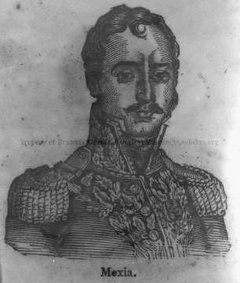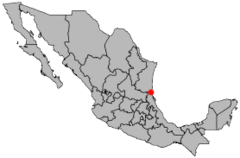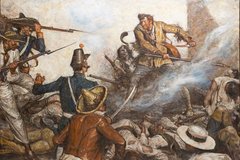By Dr. R. Bruce Winders, Former Alamo Director of History and Curation

One of the least understood aspects about the Texas Revolution is that it was part of a larger civil war between the Centralist and Federalist factions in Mexico. Areas in Mexico besides Texas vowed to support the federal republic. During the late summer of 1835, three exiled Mexican offices met in New Orleans to plan a coordinated Federalist response to Santa Anna. These men were Lorenzo de Zavala, former governor of the State of Mexico; Valentín Gómez Farías, Santa Anna’s former vice president; and José Antonio Mexía, a former officer of the Mexican Army. Gómez Faría’s role was to organize Federalist resistance throughout Mexico. Zavala’s role was to help manage the revolt in Texas. Mexía’s role was to support the Federalist effort in gulf coast state of Tamaulipas.
On October 29, 1835, Mexía wrote to the delegates from New Orleans to inform them that he would soon be leading an expedition to seize the port city of Tampico. His goal was to support a reported Federalist uprising in Tamaulipas. Mexía wrote: “I have determined to make a descent upon Tampico. . .” Within a few days he promised to load 200 men and 3 cannon onto a schooner for the trip to the Mexican coast. He stated, “Daily I am receiving communications from the interior, and lately I have received from the Governor of Tamaulipas an invitation to join in a reaction against tyranny, and in such terms, that so soon as we shall present ourselves, we shall have a force sufficient for the triumph of liberal principles.” Moreover, wrote, Mexía, “the people are only waiting for the opportunity to throw off the yoke that the servile party [Centralists] have made so heavy on their necks.”

The expedition left New Orleans on November 6, 1835. Mexía’s force, which numbered approximately 150 men, mostly Americans and Europeans, were hastily organized into military companies and instructed to elect their officers. According to several participants, the men had been told that they were going to Texas to support its fight against the Centralists. Once at sea, however, Mexía informed them of his true intent, a revelation that surprised and shocked his recruits. With little recourse, they agreed to liberate Tampico with the understanding that they would then be taken to Texas.
The Mary Jane, the ship carrying Mexía and his men, arrived at Tampico on November 14 in the middle of a gale. The ship ran around and began to break apart. Determined to take the town, Mexía’s volunteers launched an assault the next day but were driven back when expected Federalist support failed to appear and Centralist reinforcement did. Mexía’s survivors commandeered another ship and sailed for Texas.
The ill-fated expedition had two major effects on the Texas Revolution. First, Governor Henry Smith, a member of the War Party, claimed that the failed expedition showed that the Texans could expect no help from Mexican Federalists like Mexía. Members of the General Council disagreed, setting Smith and the council on a course that led to the rupture of the provisional government. Texas’ inability to mount a defense against the coming Centralist counter attack was a direct result of their bitter feud.
Secondly, not all of Mexía’s men escaped to Texas. Mexican officials captured thirty-two volunteers, a few wounded, but most lost and abandoned in the rush to leave Tampico. Officials notified their government of attack and asked for guidance. The response they received from Santa Anna was that since Mexico was not currently at war with any nation, the prisoners must be pirates and therefore executed. Despite pleas for clemency from diplomats and the men themselves, the men were shot on December 14, 1835. Santa Anna and his Minister of War, José Maria Tornel, sought to apply this principal to the revolt in Texas, ensuring that executions would become a prominent feature of the Centralist campaign to crush rebels.
BIBLIOGRAPHY
Barker, Eugene C. “The Tampico Expedition,” Quarterly of the Texas State Historical Association Quarterly. Vol. VI, №3 (January, 1903), 169–186.
By the Author. Interesting Account of the Life and Adventures of One of Those Unfortunate Men, Who Was Shot at Tampico, with Twenty-Seven of His Companions, on December 14th, 1835, With a List of All their Names, Together with the Letters, Which were Written by the Sufferers. New York: Printed and Published for the Author, 1836. https://archive.org/stream/interestingaccou00newy#page/n5/mode/2up. Accessed October 14, 2014.
Dedrick, George. “New Lights on the Tampico Expedition,” Quarterly of the Texas Historical Association Quarterly. Vol. XI, №2 (October, 1907), 175–161.
Jenkins, John H., ed., Papers of the Texas Revolution (10 vols.; Austin: Presidial Press, 1973), Volumes 2 & 3.

